When you say Jordan, one immediately thinks of Petra and vice versa. At least, I do. Petra is the most famous and most impressive archaeological, historical and cultural site in Jordan. Although certainly from its “discovery” in 1812 it gradually became famous on account of its indisputable importance, mysteriousness, interesting position and the overall value, it got its large promotion in the Western culture in the second half of the 20th century through the third sequel of the Indiana Jones films the picturesque ending of which was shot right here.
Over time, the city of Wadi Musa developed very close to the site and today this place serves mostly to meet the needs of a large number of tourists who come here precisely in order to visit Petra.
And that was what I did, right after I had left my things at the hotel – I headed for the visit of Petra. First I went down the main access street that leads from Wadi Musa to the Visitor Centre where tickets are bought. In the previous sequel of my travel stories, I mentioned that I bought a two-day ticket. The plan was to visit a part of the site this afternoon and another part the following day. It was clear that there was no way I could visit all parts of Petra simply because it is huge and spreads across a large area. Not all of this area is filled with remains of ancient buildings, but one needs to get from one important place to the other and also climb to some of them because they are located at surrounding elevations.
First, let me clarify some practical aspects. The price of the tickets is not small: 50 Jordanian dinars (beginning of 2022: 66 euros) for one day, 55 JOD (73 euros) for 2 days or 60 JOD (80 euros) for three days. When I bought the ticket, I was told that the price included a guide and a horse ride. On the other hand, I did not find anywhere on the internet that the guide is included. But, let me clarify my experience a little further. I was immediately approached by a guide and he told me he could take me along one trail (there are eight of them) in order for me to have a nice view. I told him I was not interested, but he emphasised that his service was included in the price of the ticket. I was still not interested. First, I wanted to visit Petra at my own pace and that meant a lot of stops in order to take photos. Second, I wanted to visit what I felt like and not have somebody convincing me about what was “better for me.” Third, I would have to talk with him, out of politeness, and yet I did not feel like talking at all and would not enjoy any communication with him. And, finally, in the end I would have to give him a tip while not liking any of it, because it somehow goes without saying. So, I thanked him and moved on.
As for the horse ride, this is what it is about. There is a wide path from the Visitor Centre to the entrance into the Siq (a little more about this later on) which is slightly less than 1 km long. When you leave the Visitor Centre, you get to the Entrance Gate where the tickets are strictly checked and marked if they are usable for more than one day. After that gate you can see horses and horse guides. This ride that is included in the price covers that short section before entering the Siq. However, everybody says that although the horse ride should be free, since the ticket is already bought, the horse-ride operators insist so aggressively on the tip that many people advise against using this because in the end the horse riding is going to be paid additionally.
Be as it may, I was honestly not interested in the horse riding at all and so I just continued on foot along the path that leads through the area called Bab as-Siq, meaning “Gate of the Siq.”
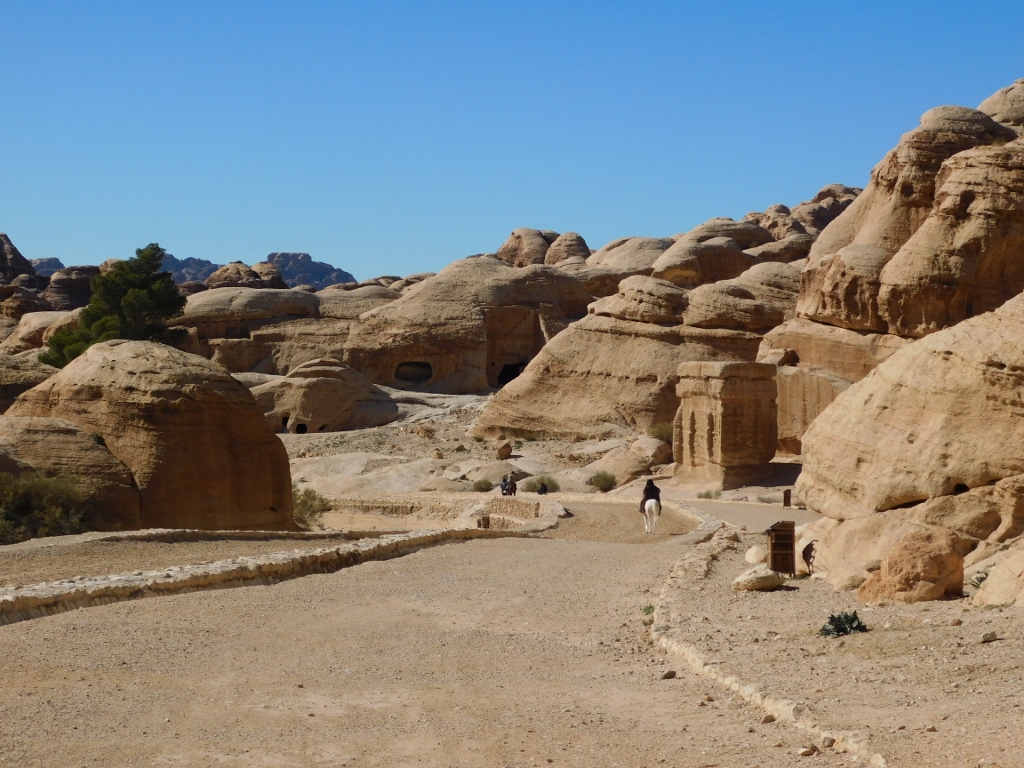 Petra, wide path at the very beginning of the site leads through the area called Bab as-Siq
Petra, wide path at the very beginning of the site leads through the area called Bab as-Siq
Already while walking along this path it is possible to see on both sides some of the monuments that were made by the Nabataeans in the period from 50 BCE to 50 CE (a little more about the Nabataeans later on). Some of them could be seen in the photo above and these are concretely called Djinn Blocks. You can also come across different names for these monuments such as block tombs or god-blocks. As I don’t have an object of reference in the photo, I should emphasise that the stone blocks seen in the photo below are tall between 6 to 8 metres!
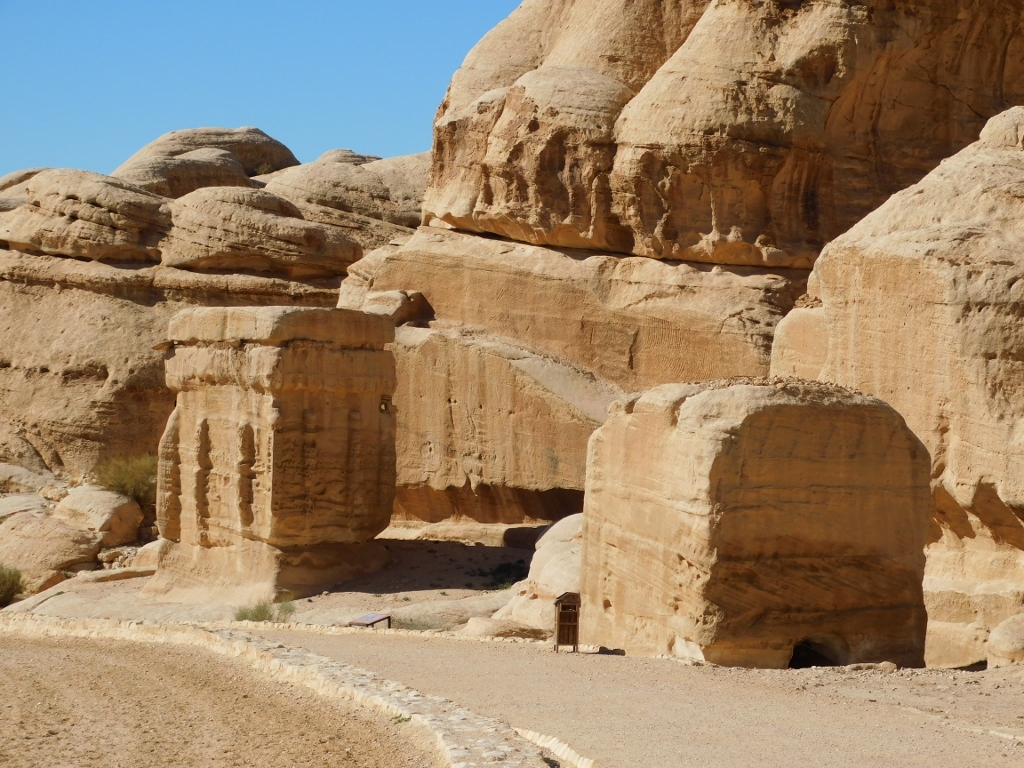 Petra, Djinn Blocks
Petra, Djinn Blocks
Such freestanding stone monuments in the shape of a cube or a cuboid can be seen throughout the entire territory of Petra. They were named after “genies” that in the Arabian culture symbolise spirits. For instance, “genie in a lamp,” often spelt “jinn” or “djinn.”
So, the Bedouins who resided in Petra believed that djinns roaming this area lived in fact in these stone monuments. Still, the researchers maintain that they were used as memorials to the dead, taking into account that there are numerous tombs around.
I don’t know about genies, but there are certainly living beings here. For instance, the mourning wheatear (Oenanthe lugens).
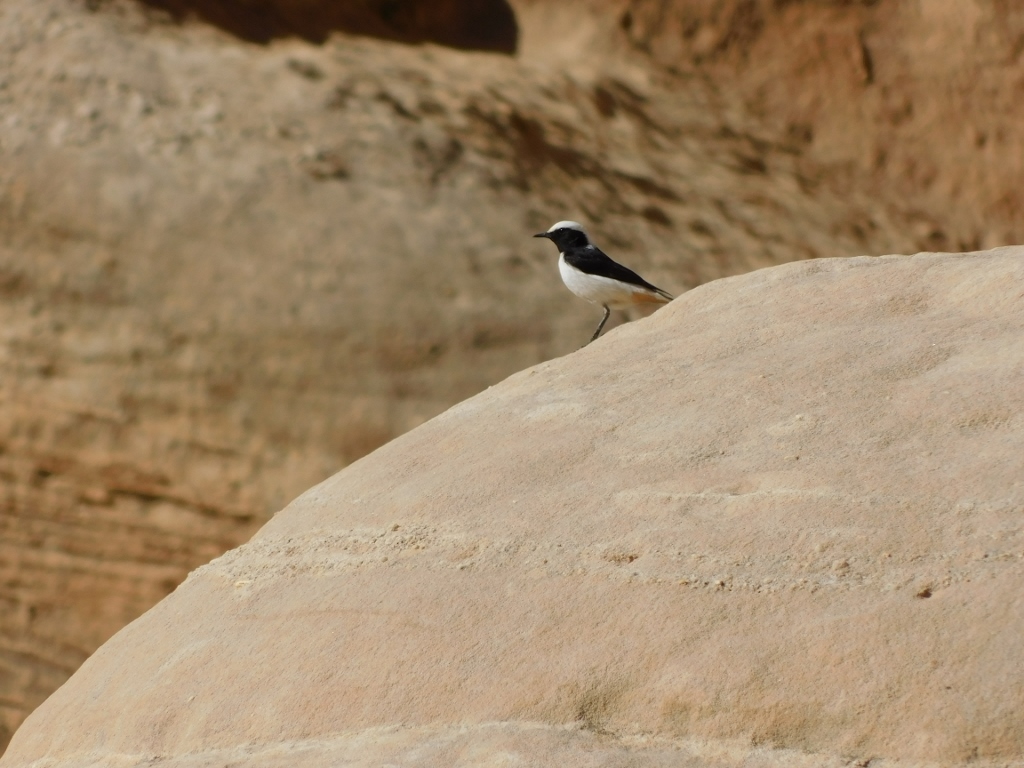 Petra, mourning wheatear
Petra, mourning wheatear
No matter how much I enjoyed looking at the lovely bird, I did come here in order to visit Petra and the next interesting monument was the Obelisk Tomb and Bab as-Siq Triclinium.
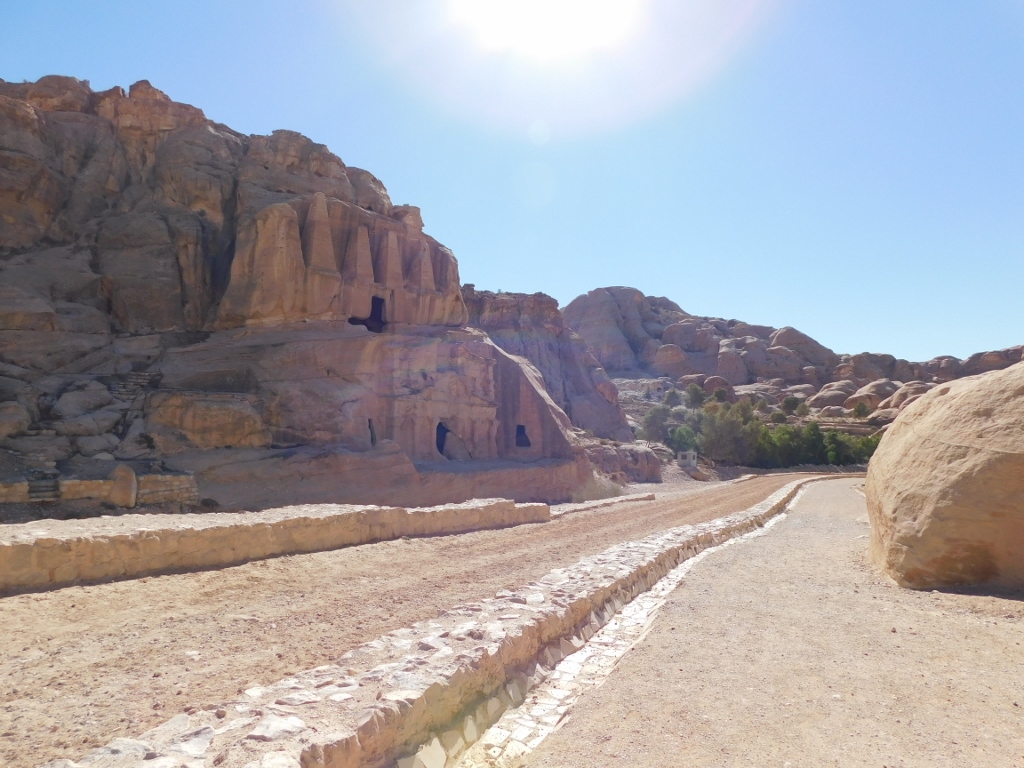 Petra, Obelisk Tomb and Bab as-Siq Triclinium, on the left-hand side
Petra, Obelisk Tomb and Bab as-Siq Triclinium, on the left-hand side
These two structures in stone can also be looked at as one, since they are one directly above the other and were made at the same time (40-70 CE).
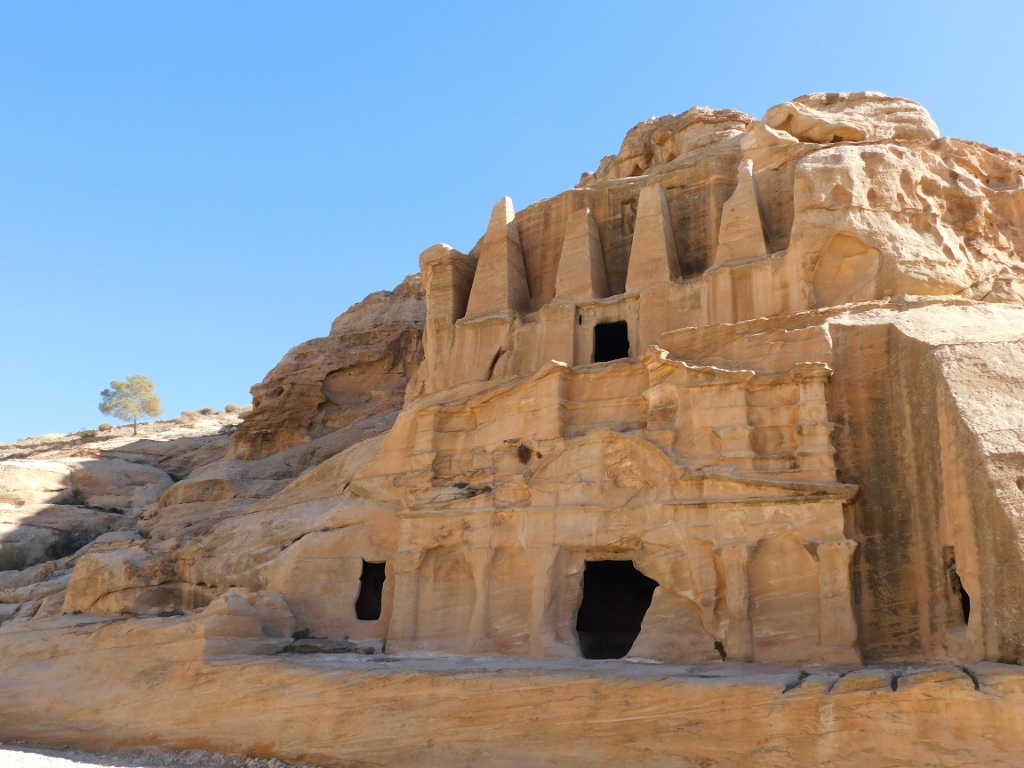 Petra, Obelisk Tomb and Bab as-Siq Triclinium
Petra, Obelisk Tomb and Bab as-Siq Triclinium
The lower section is called triclinium, which is a term from ancient Roman culture and denotes a dining room with three chaise longue around a small table. Over one hundred triclinia have been discovered in Petra and many of them are linked precisely with tombs where ritual banquets took place to celebrate the departed.
The upper section has been erroneously named the Obelisk Tomb, since these are not obelisks, but nefeshes – monuments placed at tombs so that they can be seen from afar. The highest nefesh here is 7 m high and since the Nabataean culture was aniconic (without representations of human beings), it is presumed that these nefeshes symbolise those who were buried in the graves in the inner chamber.
In this section there are also numerous carved caves where, as it is presumed, graves of poorer residents of Petra used to be. These tombs are the oldest ones carved in Petra and it is believed that they were made at the end of the 2nd and the beginning of the 1st century BCE. Only a small portion of them can be seen from the wide path leading through Bab as-Siq. Many of them were carved in the surrounding rocks, either laterally or on the top of boulders.
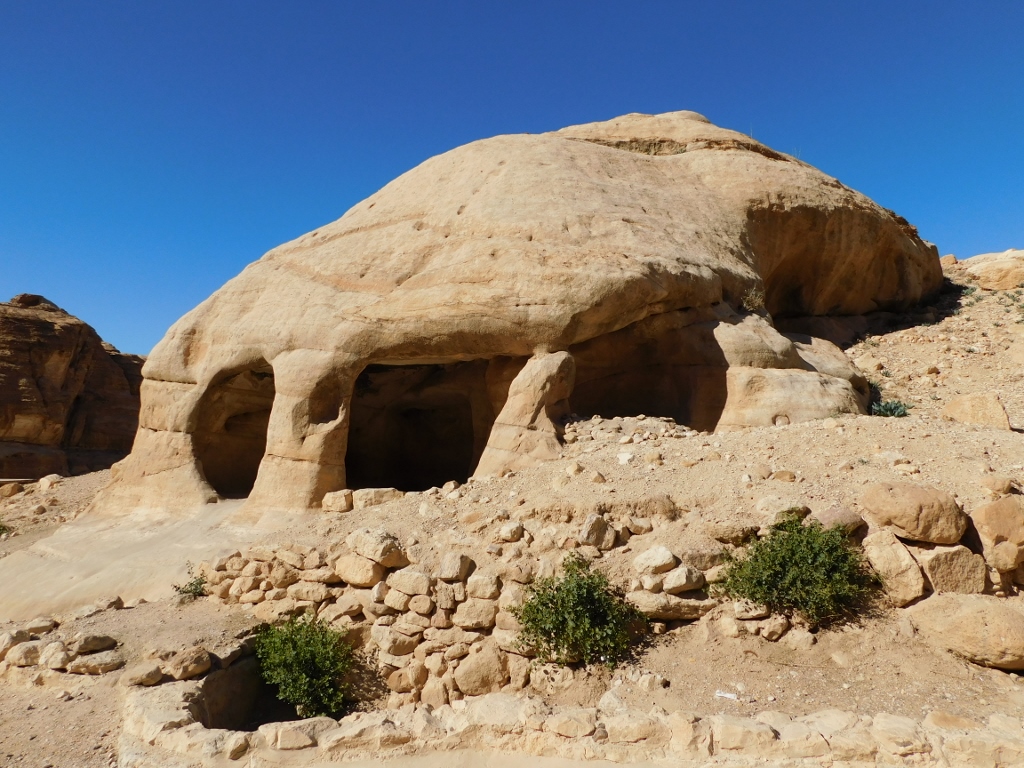 Petra, some of the carved caves in Bab as-Siq section
Petra, some of the carved caves in Bab as-Siq section
Already on the basis of what is seen here it becomes clear where the name of this site, Petra, comes from. Namely, this is the Greek word for – rock. Regardless of an occasional plant that can be seen here and there, this is basically the realm of rock. But, we should not presume that the Nabataeans called their capital using a Greek word. There are several versions of the original name for the city and one of them is Raqmu.
The side path for pedestrians, as well as the path for horses that start from the ticket checking point lead to a wider plateau where there is also a small café, toilets, a souvenir shop, etc. This is where the Siq starts.
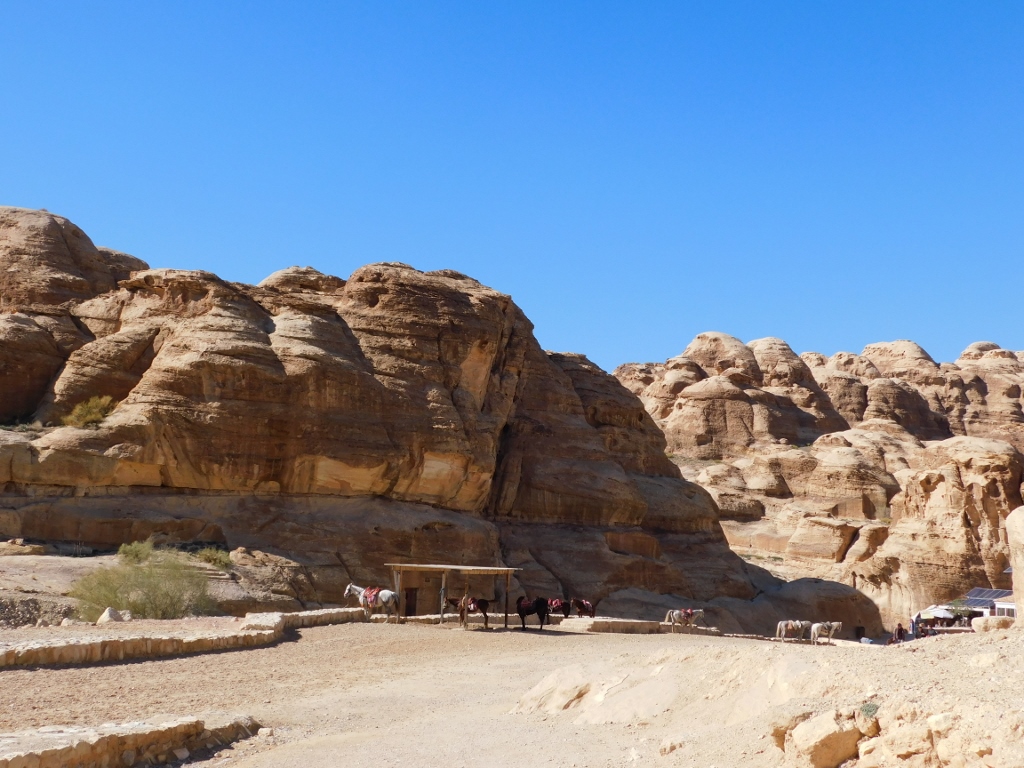 Petra, approaching the Siq
Petra, approaching the Siq
Still, before entering the Siq, on the right-hand side, before the café and the souvenir shop, there is a wide ditch and an 8-m high tunnel. To the right from the entrance into the tunnel, on the elevation, there is another djinn block.
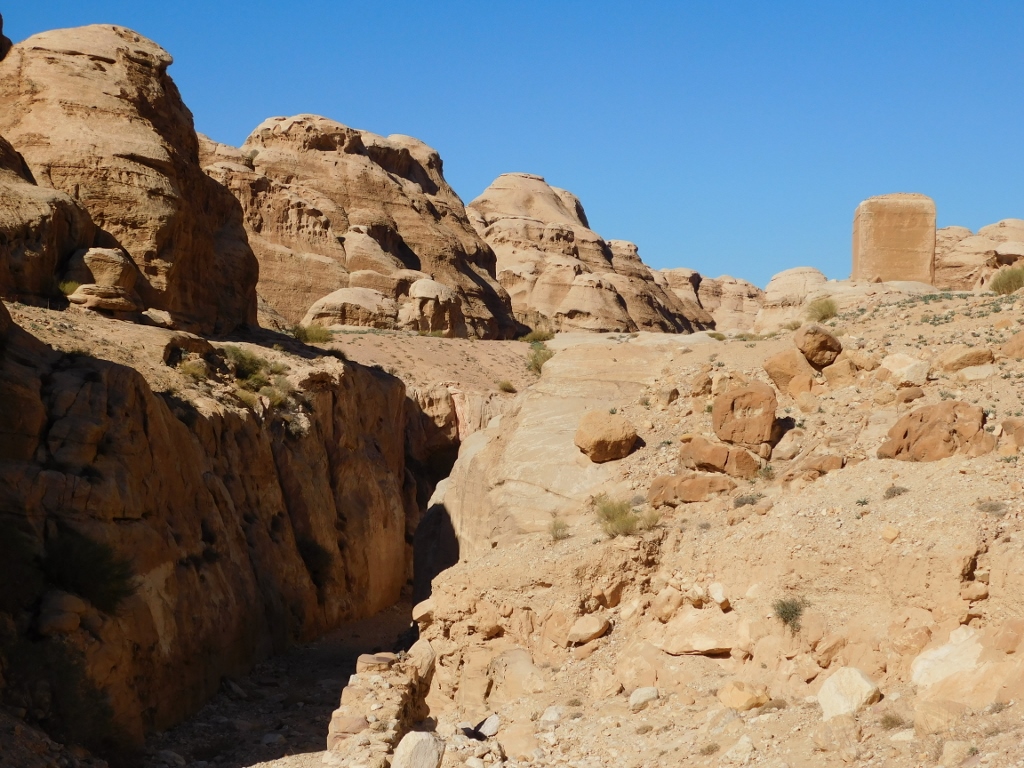 Petra, deep ditch is to the left, in the shade, while the djinn block is up and right lit by the Sun
Petra, deep ditch is to the left, in the shade, while the djinn block is up and right lit by the Sun
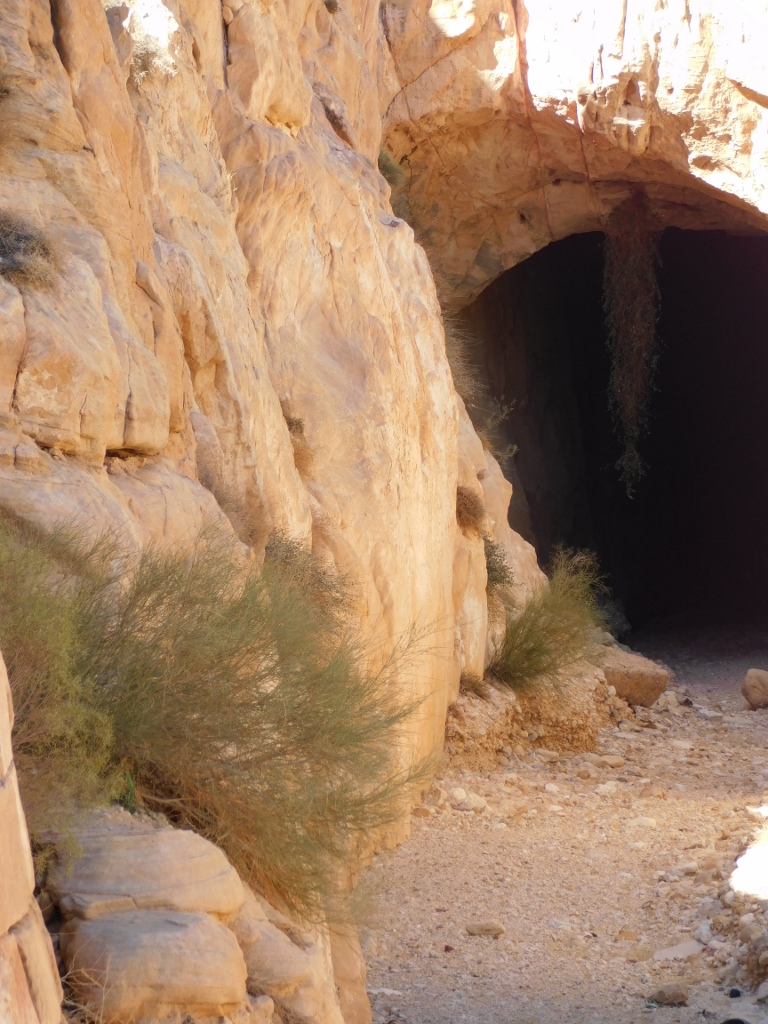 Petra, tunnel close to the entrance into the Siq
Petra, tunnel close to the entrance into the Siq
The ditch was formed here by building a dam at the entrance into the Siq in order to prevent penetration of water through the main access route to Petra, while the visitor path, i.e., the entrance into the Siq runs along a wide bridge over the ditch.
This ditch and the tunnel were used to guide flash floods, but nowadays visitors may enter Petra along that trail, too. Still, during the rainy season (from November to March), one should be extremely careful since flash floods can form quickly and then the passage here is very dangerous and probably prohibited when it rains.
There are numerous valleys in Petra that are called “wadi” in Arabic and that are in fact often merely passages between rocky elevations through which these seasonal water flows run. Thus, this trail through the tunnel leads to Wadi Muthlim and judging by the description in my guidebook this is a very picturesque trail that somewhat further leads to yet another, open valley, Wadi Mataha. In this way, the visitor would reach the centre of Petra by an indirect route.
Still, the main route to the centre of Petra is so impressive, wonderful, spectacular and unique that the visitor must walk there at least once. I went four times and have no regrets about it, because that was something I dreamt of for a long time.
This is the Siq, often marked as As Siq.
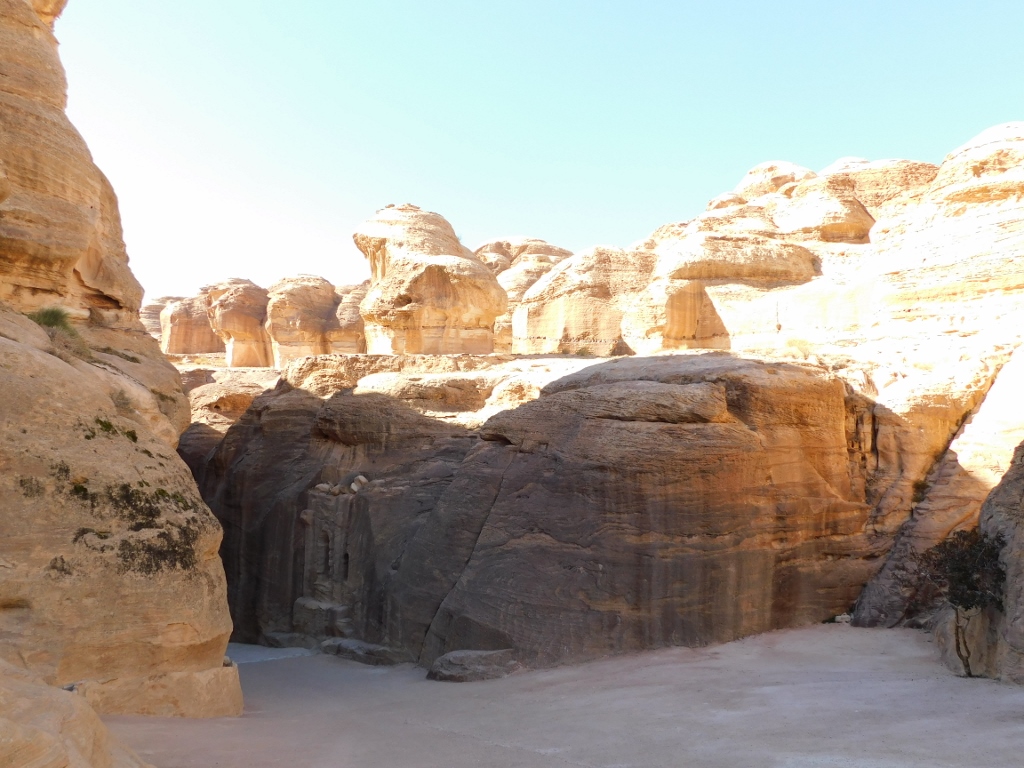 Petra, entrance into the Siq is to the left
Petra, entrance into the Siq is to the left
The Siq means “gorge” and this is the main entry to Petra. At the same time, this is a magical, natural formation and when you stand at the entrance into the narrow gorge you cannot even begin to imagine what is there for you to see along the gorge and on the other side. The gorge was created thanks to tectonic forces that “ripped apart” the mountain and then over time flash floods and wind, with their erosive action, shaped this passage additionally.
There is evidence that people inhabited Petra area already from 7000 BCE in the Neolith. Later, obviously under different name, Petra was mentioned in ancient Egypt, as well as the Old Testament. By the way, a local, Arabian legend says that it was right here that Moses (Musa) struck a piece of rock with his staff and then the water started to flow so that the Israelites could refresh. Even today, there is a spring in the town of Wadi Musa and it is called Ain Musa or Moses Spring, while the name of the town means Valley of Moses. It was precisely from this spring that the water flowed through the valley and onwards towards Petra, since the Nabataeans made channels for bringing the water from this spring to Petra.
But here, at the entrance into the Siq, a dam was built, first in the past, but then also in the contemporary times, that prevented flash floods passing through the main access route leading to the city. When you stand at the entry point to the Siq, you already get a very good idea of what this passage looks like. By the way, along the left-hand side of the photo below (towards the top), one can see remains of an arch that used to decorate the entrance. The arch was destroyed in the 1898 earthquake.
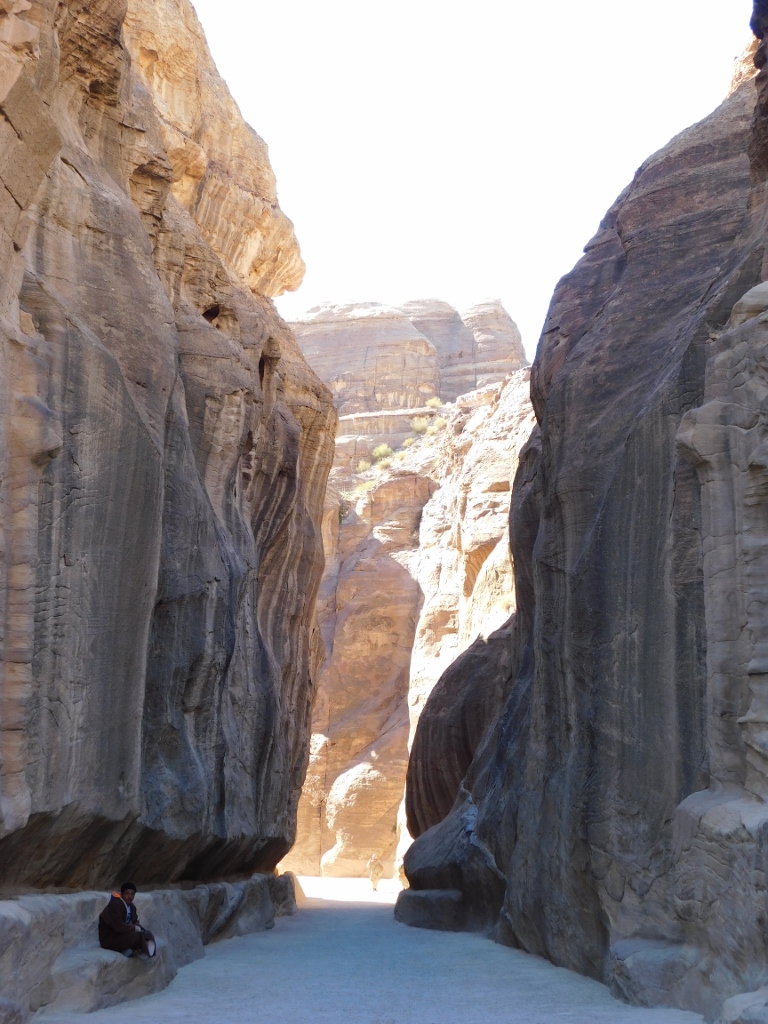 Petra, entrance of the Siq
Petra, entrance of the Siq
Now I must emphasise a couple of things. When you see this in person, it all looks much more impressive and better than in my photographs. First, you are on the spot, surrounded by the gorge and this creates a feeling that no photograph can ever convey. Second, I don’t know how to take photos well so that they show equally the colours that are in the shade and the blue sky and the dazzling sunlight above the gorge, on account of the too large a contrast in the quantity of light. The human eye, or better said the human brain, manages to overcome that light contrast quite well and that is why the impression on the spot is visually significantly better than in my photographs. Here and there, a few photos manage to overcome this, but I hope that the readers will have understanding and that they will use their imagination.
And one other thing. Petra is often called the Rose Red City. The reason for that is the colour of the rocks that is mostly red. This in combination with the blue sky is absolutely spectacular.
So, let us now proceed with the walk through the Siq. To start with, here is a short video that illustrate both the colour of the rocks and the colour of the sky, as well as the entrance into the gorge.
The Siq is about 1.2 km long and in some places it is only 3 m wide. The height of the cliffs that surround it goes from 91 to 182 m (some sources say that it is 70 m).
In the past, the Siq was used as the main entryway to Petra and this space was sacred for the Nabataeans. How is this known? Simply, in several places along the Siq there are votive niches in which often there are betyls or sacred stones, or small altars for incense.
Already at the very beginning of the Siq, on the right-hand side, it is possible to see a votive niche carved in the stone and an aedicula (a miniature shrine), as well as steps leading to them.
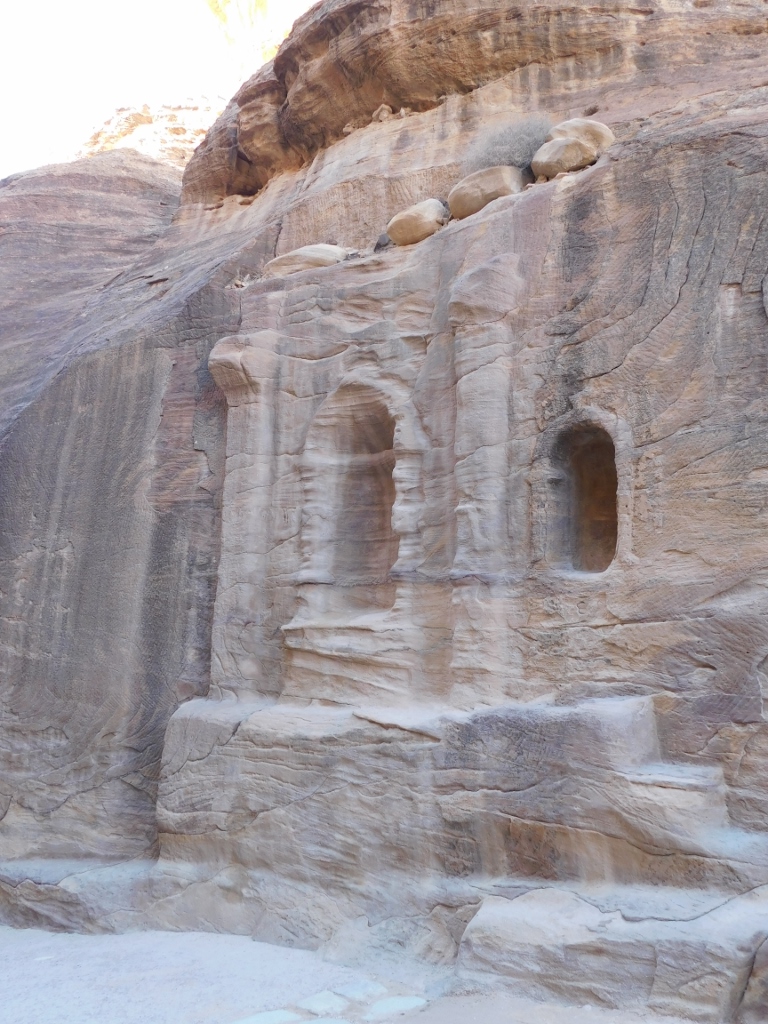 Petra, votive niche, at the beginning of the Siq
Petra, votive niche, at the beginning of the Siq
Still, what fascinated me most here was the walk through the gorge, on account of its colours, mystique, specificity and indisputable beauty, and all of that was particularly accentuated because I was here in January when the tourist season is absolutely low. One should keep in mind that there are reasons for this. Namely, a couple of days before my arrival in Petra and a couple of days after my visit, it snowed here!!! I have no doubts that snow in Petra may create some dramatic effects, but it is certainly much easier and better to visit the site in dry weather, especially when there is a lot of sunlight.
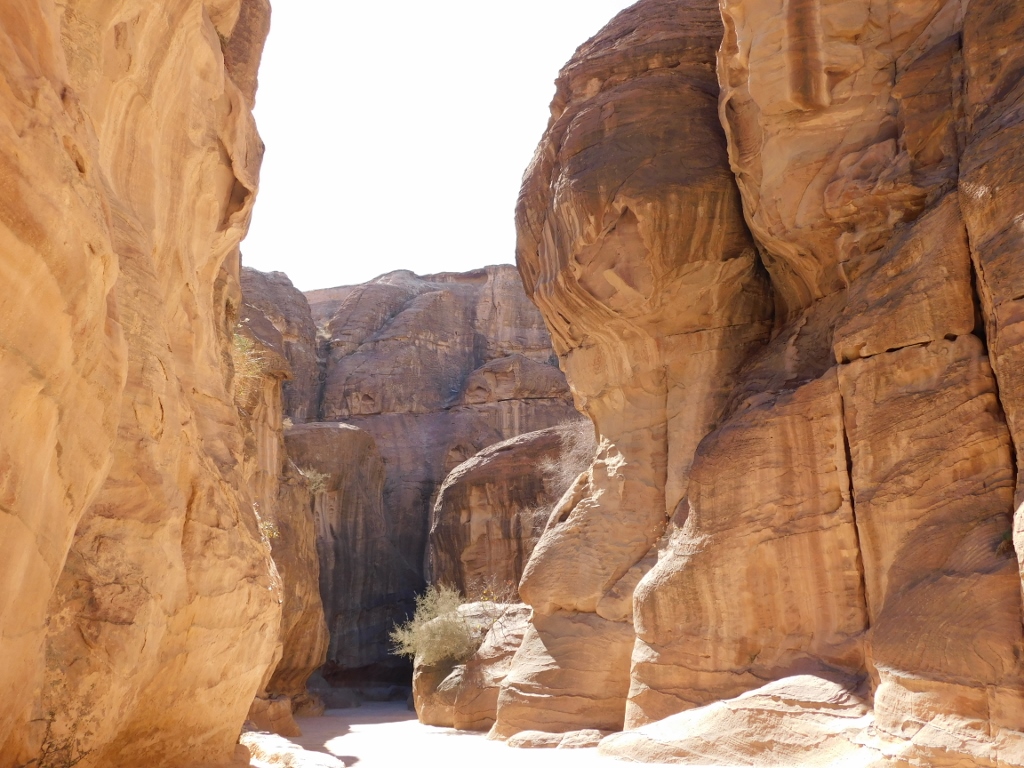 Petra, the Siq, a detail
Petra, the Siq, a detail
From time to time I came across local Bedouins who walk here probably because of tourists to whom they can offer, for instance, their guide services or maybe they had already finished with some guiding and were now going back. Nobody offered me anything and that was more than fine with me. Their occasional presence was also good in order to provide reference about the size of the Siq and the walk through it.
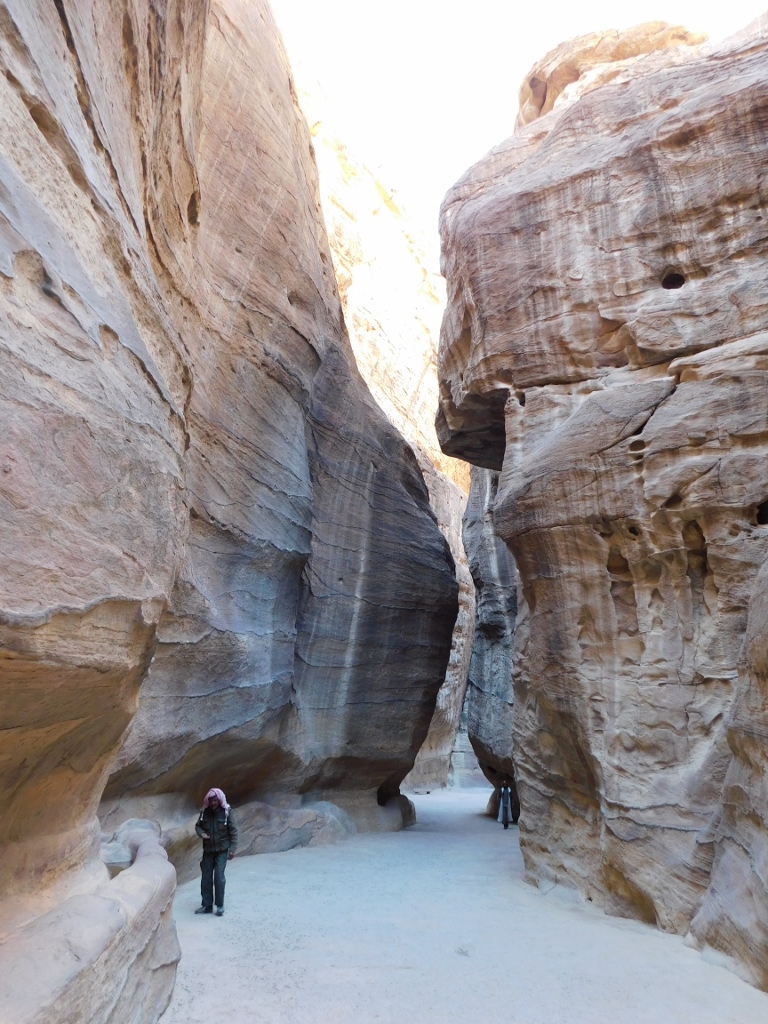 Petra, the Siq, a detail with people
Petra, the Siq, a detail with people
Still, I must admit that I did not miss people at all. Quite the contrary. Maybe I’m an eccentric, but I enjoyed thoroughly and in this section I was mostly completely alone, except that from time to time I could hear human voices, but not too often.
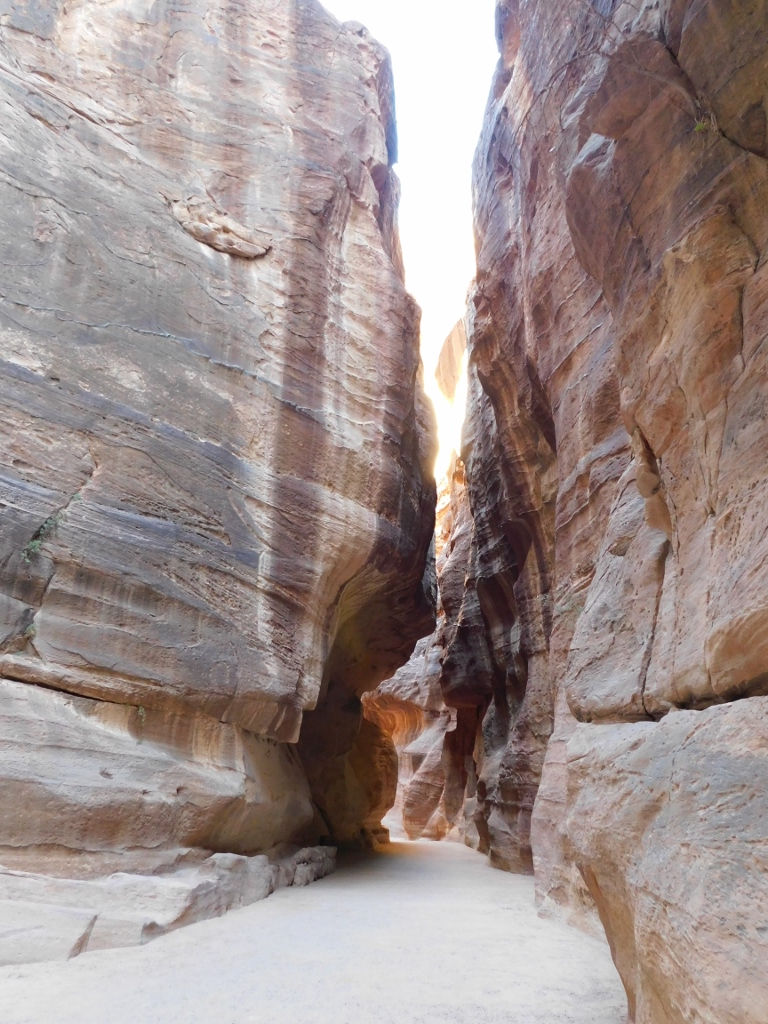 Petra, the Siq, narrow section without people
Petra, the Siq, narrow section without people
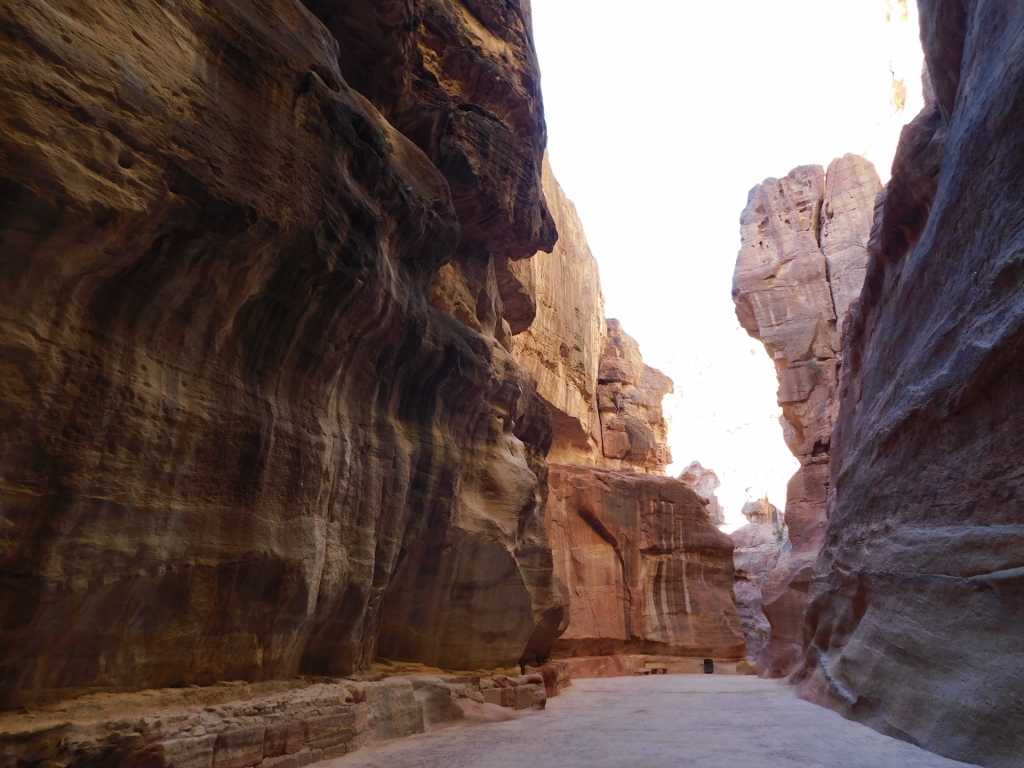 Petra, the Siq, wide section without people
Petra, the Siq, wide section without people
For those who would like to have such an experience, let me reiterate that I was in Jordan in January, plus I came here around 2 pm (on my first day). The rare tourists I did encounter in the Siq were already coming back from their visit.
Petra is situated in a broad valley that is like a funnel surrounded by rocky hills. In other words, everything is naturally dry here and at first sight this seems like an absolutely unsuitable place for any human settlement and its development. Still, the Nabataeans provided drinking water from the surrounding springs, among other ways by bringing it along channels or terracotta pipes that were kilometres long. Thus, it is possible to see clearly water channels carved by the Nabataeans.
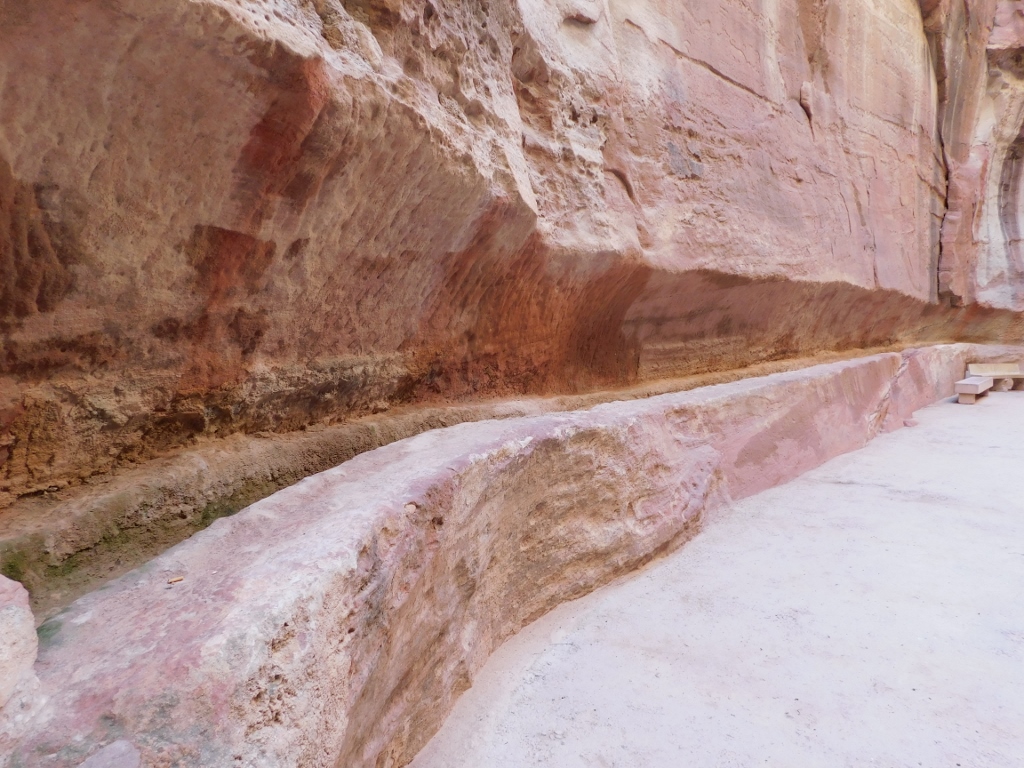 Petra, the Siq, water channel carved towards the bottom of the cliff
Petra, the Siq, water channel carved towards the bottom of the cliff
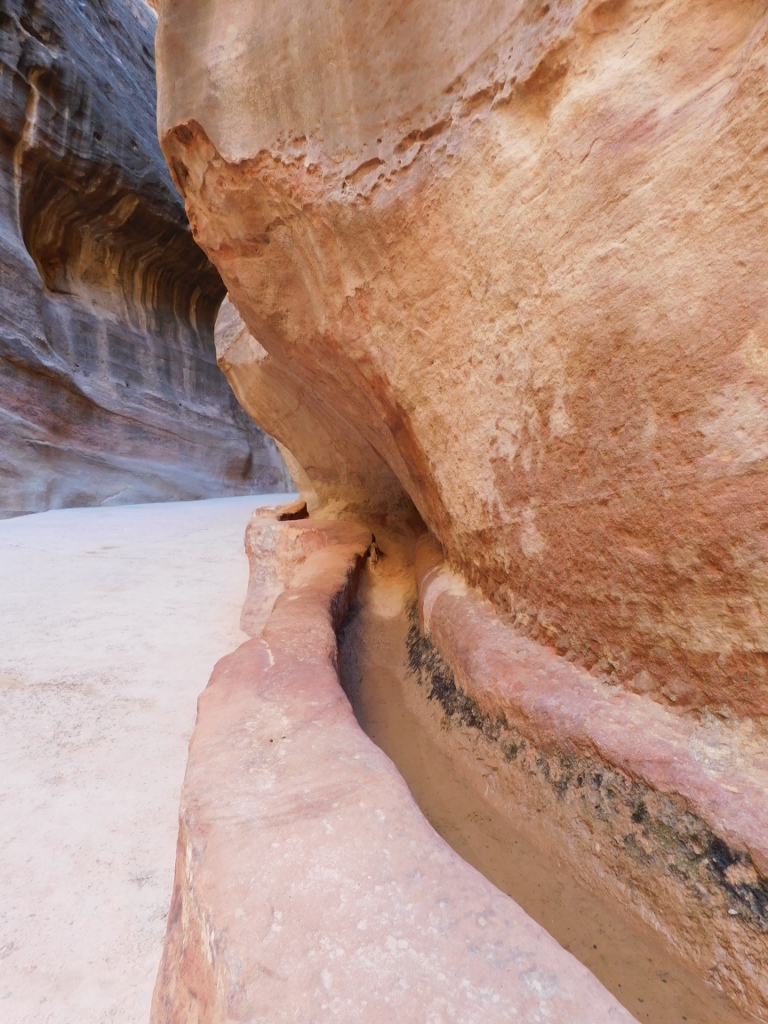 Petra, the Siq, water channel carved towards the bottom of the cliff
Petra, the Siq, water channel carved towards the bottom of the cliff
As you walk here, it is possible to notice numerous details. For instance, in one place, on the north side of the Siq (the right-hand side when walking from the entrance towards the centre of Petra), you can see another aedicula that is some 2.5 m high. It is precisely the six small pillars, or better said pilasters, on the top that are considered the betyls or sacred stones.
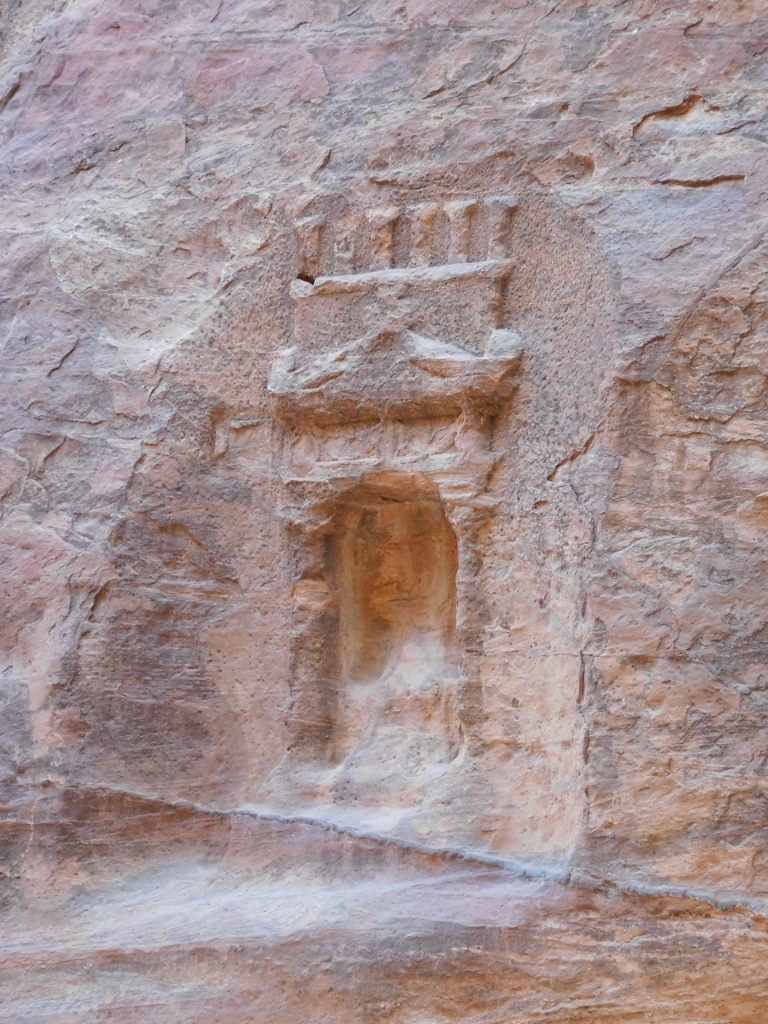 Petra, the Siq, a detail with the aedicula
Petra, the Siq, a detail with the aedicula
The Nabataean religion was aniconic, i.e., the God was represented symbolically and not in the shape of a human figure. When one visits Petra, it becomes quite clear that in the centre of the Nabataean religion there was – the rock, since rocks and cliffs are all around you. But it is important that the rock, i.e., the betyl does not represent the God himself or his image, but rather this is a medium that carries the presence of God within itself, this is the House of God, which is also the root meaning of word “betyl” that originates from the Semitic languages.
At one point I reached a wider section of the Siq and there, in addition to a couple of people who walked, I also saw an electric golf-cart used for those visitors who cannot walk for too long.
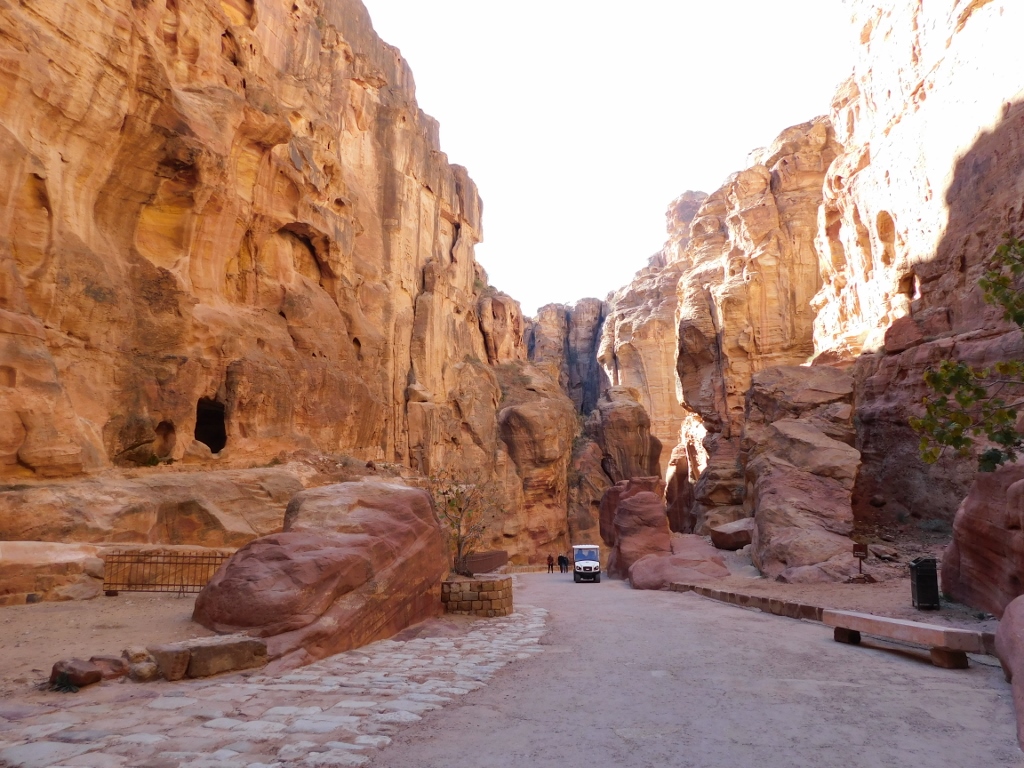 Petra, the Siq, a detail
Petra, the Siq, a detail
As I’ve said, in some places the Siq is but a couple of metres wide, but there are also some wider sections, such as the one seen in the previous photo that is around 15 m wide. Within the boulder seen to the left from the path, there is a carved aedicula that was fully revealed only in 1977.
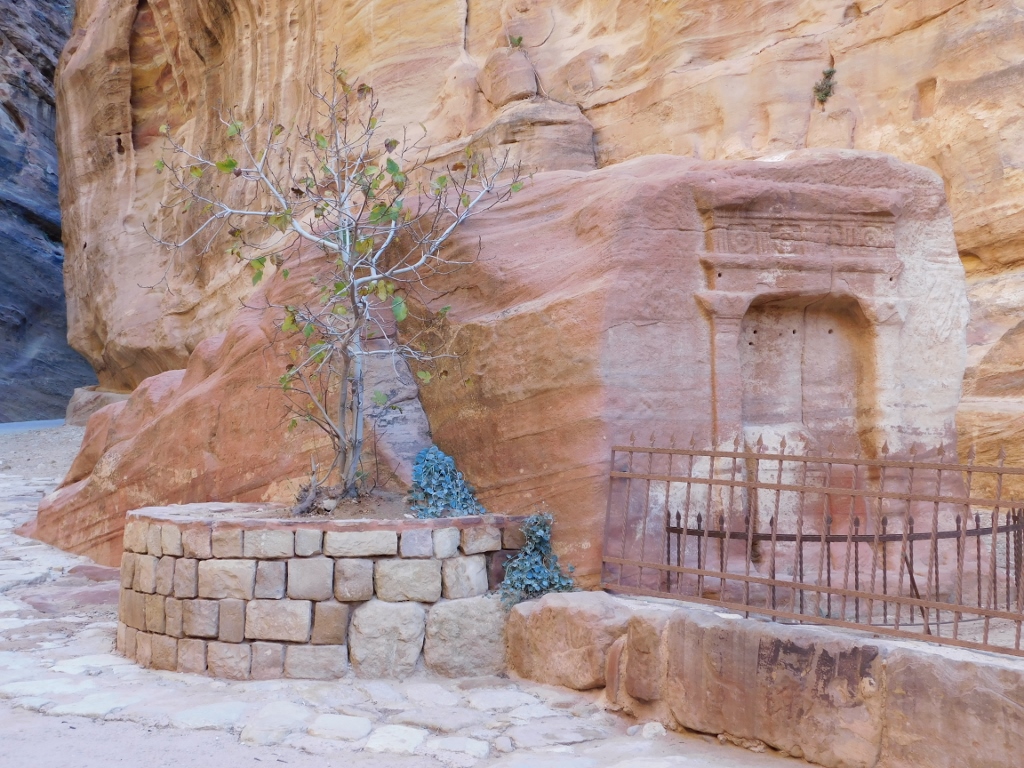 Petra, the Siq, a detail with the aedicula
Petra, the Siq, a detail with the aedicula
This shrine is almost 2.5 m high and was made in the shape of a temple gate. Among other details, in the lower half of the “temple gate”, it is possible to see two betyls that cannot be discerned clearly in the photo above on account of the metal fence.
On the cliff above this aedicula, it is possible to see remains of an old temple reached by visible stairs.
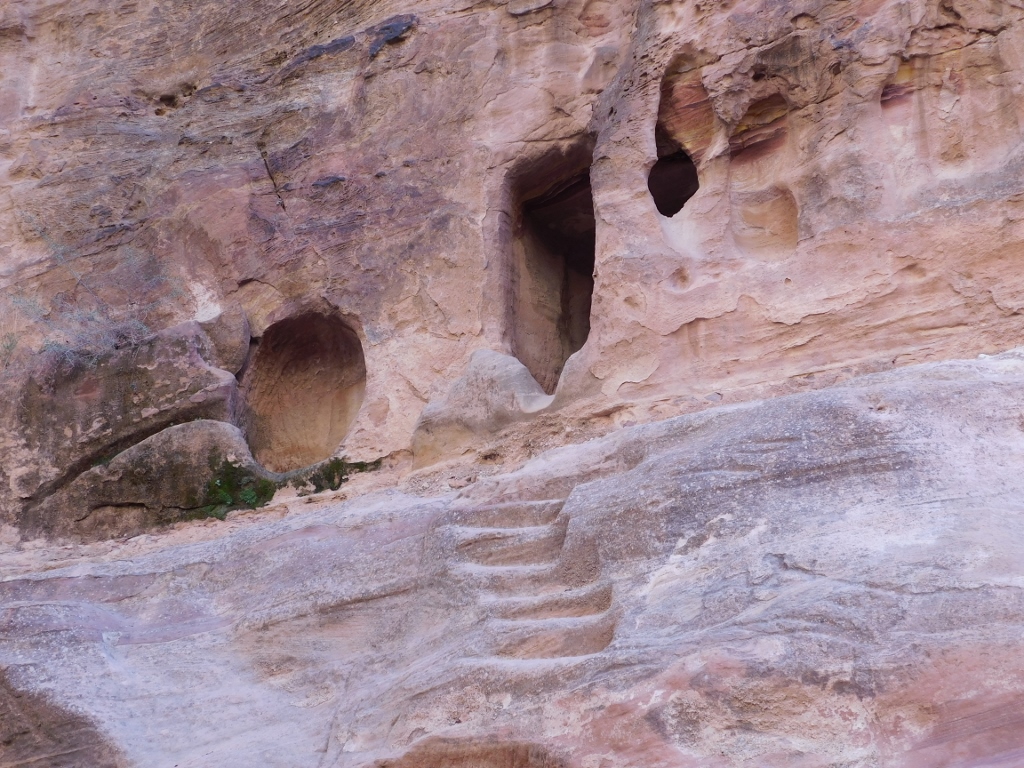 Petra, the Siq, a detail
Petra, the Siq, a detail
Here I took advantage of the wider space and the larger quantity of sunlight, making photos of the surrounding rocks, as well as the sky.
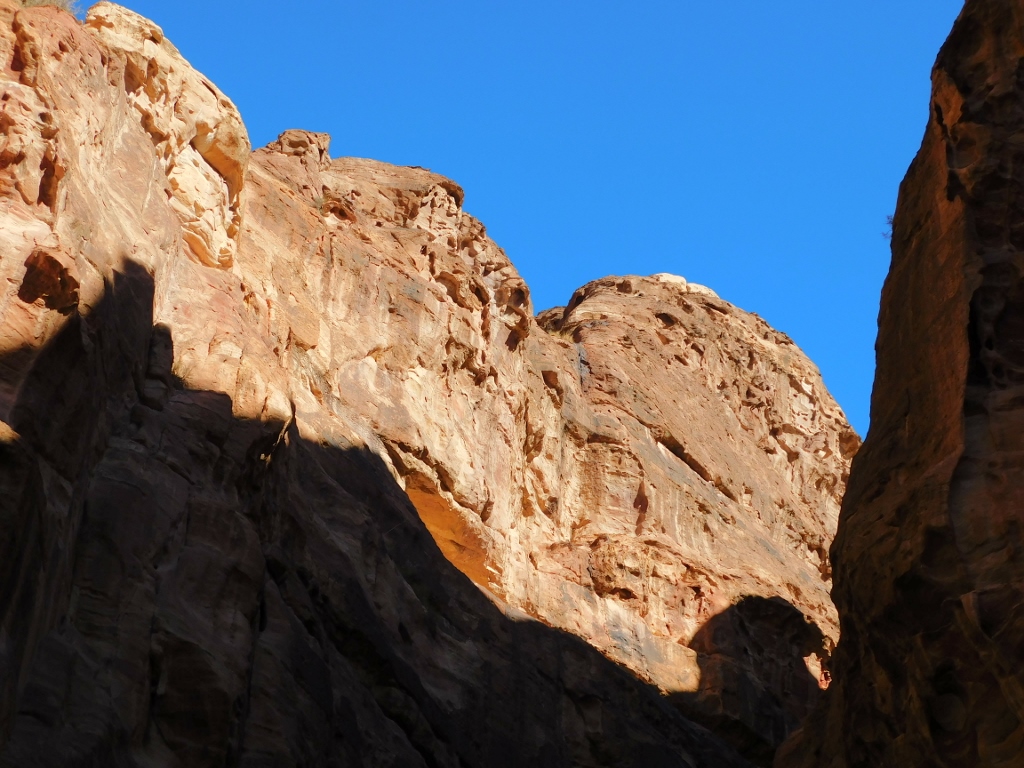 Petra, the Siq, a detail with blue sky
Petra, the Siq, a detail with blue sky
In some places it was possible to see parts of the cliffs that were multi-coloured and that seemed utterly incredible.
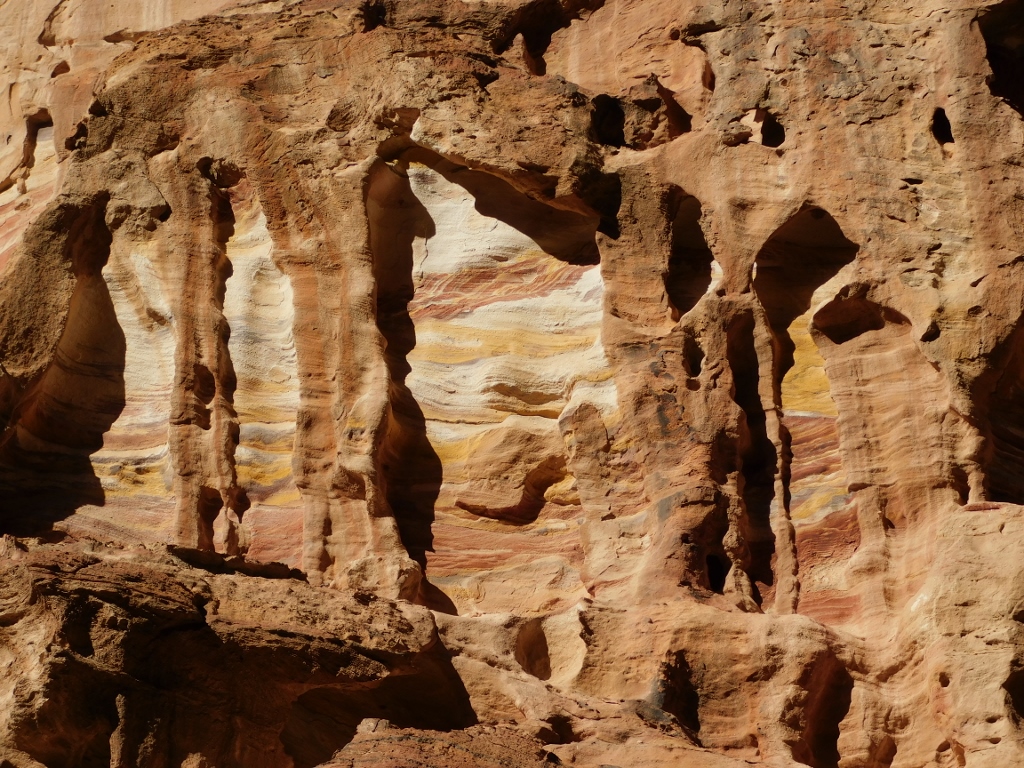 Petra, the Siq, a detail with a multi-coloured rock
Petra, the Siq, a detail with a multi-coloured rock
After this short break in order to take photos, I was ready to continue walking down the Siq.
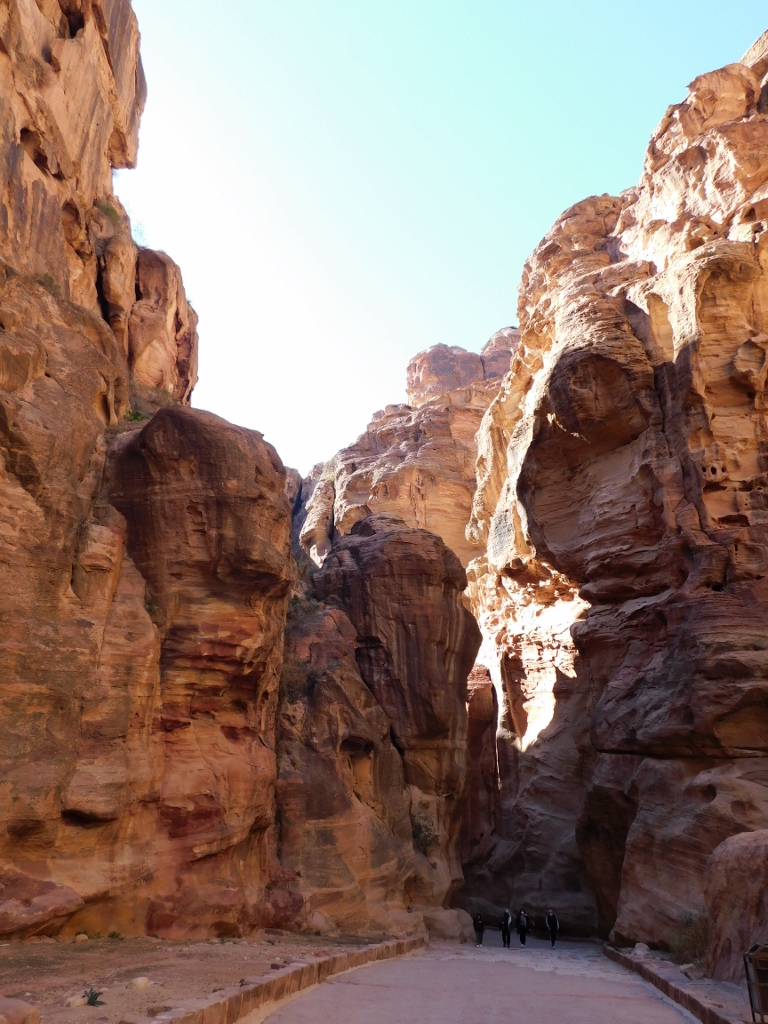 Petra, the Siq
Petra, the Siq